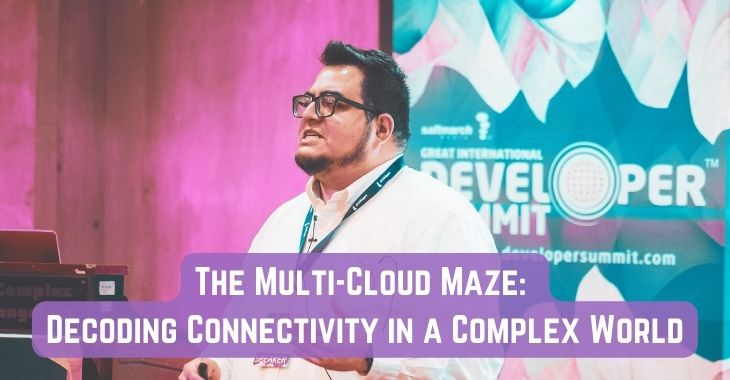
“Once again Saltmarch has knocked it out of the park with interesting speakers, engaging content and challenging ideas. No jetlag fog at all, which counts for how interesting the whole thing was."
Cybersecurity Lead, PwC

Exploring the complexities of cloud-native applications, especially the challenges associated with connectivity in multi-cloud environments, uncovers a dynamic and evolving technological landscape. This article draws on the expertise of industry specialist Hugo Guerrero to offer a detailed view of both the current state and prospects of cloud connectivity. Guerrero's insights provide a crucial perspective, helping to navigate and understand the rapidly changing world of cloud technology.
"We used to live in an Eden where everything was good, and everyone was happy with the monolith or the single cluster. But it was limited, and we faced troubles as we realized the need to spread across the world with our data centers."
The IT landscape has undergone a major transformation, moving from the integrated, interdependent nature of monolithic systems to the dynamic, multi-cloud environments of today. This shift, spurred by the rise of cloud computing, represents a significant change from traditional IT setups, offering enhanced scalability and flexibility. Businesses are increasingly adopting multi-cloud systems for their agility, enabling quick adaptation to market changes and avoiding dependence on a single cloud provider. A key factor in this transition is the need to navigate diverse global data regulations, with multi-cloud solutions providing a way to comply with various regional data protection laws. Economically, this move towards multi-cloud environments is strategic, allowing companies to optimize resources, benefit from competitive pricing, and avoid vendor lock-in. However, this evolution is not without challenges, such as integrating different systems, synchronizing data, and ensuring uniform security across platforms. Despite these obstacles, the move to multi-cloud systems marks a significant advancement in IT, meeting the evolving needs of contemporary businesses.
"In the multi-cloud reality, you find yourself juggling services from various providers, each with their unique strengths, leading to a complex web of connectivity and integration challenges."
Building on the significant shift towards multi-cloud environments, organizations are now embracing the complexities that come with this new landscape. The adoption of multi-cloud strategies has become a necessity for many, as it allows them to leverage a diverse range of services from various providers. Each provider offers distinct advantages, such as advanced AI capabilities or more economical storage options. This variety enables businesses to tailor their IT infrastructure to their specific needs.
However, this hybrid approach is not without its challenges, particularly in terms of connectivity and application deployment. The integration of services from multiple cloud providers demands a high level of coordination. Developers are tasked with the crucial role of ensuring that these services communicate seamlessly with one another, despite being on different platforms. This requirement for seamless integration extends beyond mere technical compatibility; it involves creating a cohesive environment where data and applications can interact without friction, regardless of their underlying cloud infrastructure.
The complexity of this task cannot be understated. It requires a deep understanding of each platform's unique features and limitations, as well as a strategic approach to integrating these disparate systems into a functional, unified whole. This challenge is central to the successful implementation of multi-cloud strategies, as it directly impacts the efficiency and effectiveness of the organization's IT operations.
As organizations navigate the complexities of multi-cloud strategies, understanding the various connectivity patterns that have emerged in this era is crucial. These patterns are pivotal in addressing the challenges posed by the hybrid nature of multi-cloud environments:
Navigating through the multi-cloud era, the focus shifts to overcoming the myriad of connectivity challenges that arise in cloud-native environments. These challenges are not just technical but also operational, encompassing a wide range of issues from managing diverse clusters and virtual machines to handling different operating systems.
One of the key hurdles in this landscape is the complexity of network configurations, such as setting up and managing firewalls and resolving IP conflicts. These tasks, while crucial for security and smooth operation, can be time-consuming and complex, often diverting developers' attention away from their primary focus of building and deploying applications.
To address these challenges, there is a growing need for solutions that simplify the connectivity aspect of cloud-native environments. The goal is to streamline these processes, reducing the burden on developers and allowing them to dedicate more of their time and resources to innovation and development. By simplifying these aspects of infrastructure management, developers can focus on creating more efficient and effective applications, enhancing the overall productivity and agility of the organization.
In essence, the ability to effectively manage and simplify connectivity in cloud-native environments is becoming increasingly important. It's not just about ensuring technical compatibility across various platforms but also about creating an operational environment that supports and enhances the work of developers. This approach is crucial for organizations looking to fully leverage the benefits of multi-cloud strategies and maintain a competitive edge in the fast-paced world of technology.
"The goal in modern cloud-native applications is to see connectivity as a mesh – a seamless fabric interconnecting all components, regardless of location, fostering a more responsive and agile environment."
As we look towards the future of cloud connectivity, a transformative concept is taking shape: the idea of connectivity as a mesh. This innovative approach envisions a world where all components of an application are seamlessly interconnected, transcending geographical boundaries. Such a mesh of connectivity would enable the capture and processing of events anywhere within the application's architecture, ushering in a new era of flexibility and responsiveness.
This mesh approach is more than just a technical advancement; it represents a paradigm shift in how developers interact with cloud infrastructure. By abstracting the complexities of connectivity, this model aims to liberate developers from the intricate details that often constrain their creativity. Freed from these limitations, developers can focus more on the creative aspects of application development, exploring new possibilities and innovations.
The promise of this future is a more agile and adaptable cloud environment, where the flow of data and services is as natural and unimpeded as communication in a well-orchestrated network. This level of integration and ease of interaction is poised to significantly enhance the efficiency of cloud-based operations, enabling businesses to respond more swiftly to changing market dynamics and customer needs.
In essence, the future of cloud connectivity is not just about more robust networks or faster data transfer; it's about creating an ecosystem that supports and fosters creative and unrestricted development. This vision of a connected cloud future is a testament to the ongoing evolution of technology, opening new horizons for innovation and progress in the digital world.
"Adapting to the dynamic landscape of cloud-native applications requires an understanding of the evolving connectivity patterns. The key is simplifying connectivity so developers can focus on building applications, not infrastructure complexities."
In conclusion, as the IT landscape evolves from traditional monolithic systems to the more intricate multi-cloud environments, the guidance and insights from industry experts become increasingly vital. Figures like Hugo Guerrero offer valuable perspectives that help demystify the complexities of cloud connectivity. Their expertise sheds light on the importance of developing efficient and effective connectivity patterns, which are essential for any organization looking to maintain a competitive edge in a landscape increasingly influenced by cloud technologies.
This ongoing evolution in cloud technology demands not only technical acumen but also a strategic approach to adaptability. Staying informed and flexible is crucial for success in this rapidly changing field. As organizations navigate through these changes, the ability to effectively manage cloud connectivity will play a pivotal role in determining their future growth and sustainability.
The journey through the cloud connectivity landscape is an ongoing process of learning and adaptation. Embracing this journey with a keen understanding of its complexities and opportunities is what will enable businesses and developers alike to thrive in the ever-evolving world of cloud computing.
Watch the full video of the talk, here.
Questions or comments? Interested to contributing an article? Reach out to us here.
Banner Image Credits: Hugo Guerrero at Great International Developer Summit

“Once again Saltmarch has knocked it out of the park with interesting speakers, engaging content and challenging ideas. No jetlag fog at all, which counts for how interesting the whole thing was."
Cybersecurity Lead, PwC

“Very much looking forward to next year. I will be keeping my eye out for the date so I can make sure I lock it in my calendar."
Software Engineering Specialist, Intuit

“Best conference I have ever been to with lots of insights and information on next generation technologies and those that are the need of the hour."
Software Architect, GroupOn

“Happy to meet everyone who came from near and far. Glad to know you've discovered some great lessons here, and glad you joined us for all the discoveries great and small."
Web Architect & Principal Engineer, Scott Davis

“Wonderful set of conferences, well organized, fantastic speakers, and an amazingly interactive set of audience. Thanks for having me at the events!"
Founder of Agile Developer Inc., Dr. Venkat Subramaniam

“What a buzz! The events have been instrumental in bringing the whole software community together. There has been something for everyone from developers to architects to business to vendors. Thanks everyone!"
Voltaire Yap, Global Events Manager, Oracle Corp.